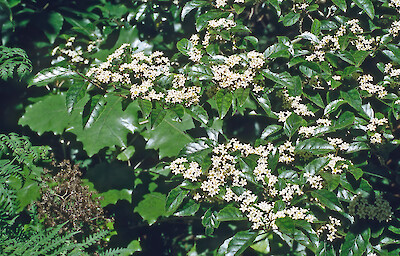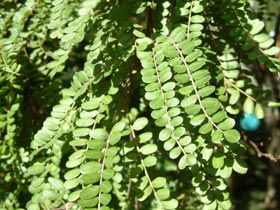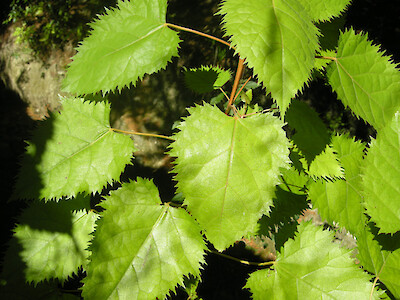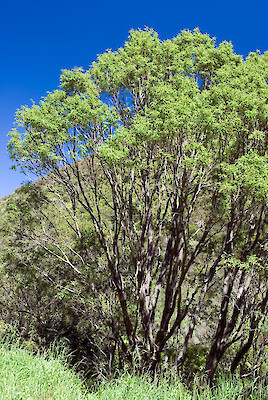Tree guide
Welcome to the Styx Living Laboratory's tree guide
This guide will help you learn a little more about our native trees so you understand if you have the right place in your garden to plant them.
The trees listed here are regularly planted at our planting days as we aim to increase the tree canopy cover as part of our effort to restore the Styx river catchment.
If you recently received a tree on your doorstep from the Murchison Park Project, it will have a colored sticker on the pot. The sticker colour will help you work out what tree you have received. Scroll down or look in the banner to the right of this webpage to find out more.
Source, references and further reading
Thank you to the New Zealand Plant Conservation Network - https://www.nzpcn.org.nz/ for allowing us to share their knowledge and content of our native plants
Tree Planting Instructions
Planting trees is a great thing to do because they help reduce soil erosion, create shade and shelter and reduce the level of carbon dioxide. They also provide habitat for native birds and other animals. With out trees and rivers and waterways and the creatures within would also suffer.
- Select a good location. Consider how much space the tree will need, if it will get enough sun or shade.
- Dig a hole which will give enough room to allow the roots of the plant to be spread out evenly without touching the sides of the hole (about twice the size of the root ball).
- In heavy or clay soils, hole width is more important than depth.
- If plants are tight around the roots when coming from a planter bag or pot, it is generally a good idea to loosen the root ball.
- You don't need to but if you are introducing new soil, compost or a planting mix, ensure it is well mixed with the existing soil from the site.
- If adding fertiliser make sure it is well mixed in with the soil that is going back into the hole and not put in a pile at the bottom.
- Backfill to depth, just above the depth of soil in the pot.
- After planting make sure soil is firmly packed to avoid plant movement or rocking which will inhibit new root development.
- Water regularly during establishment period and subsequent dry spells. Remember not to overwater.
- Mulching around the plant with a bark mulch 100mm thick will help with moisture retention and help keep down competing weeds. Be careful not to push directly up to main stem of the plant as it can cause rot.
- After heavy winds check newly planted stock and firm up if necessary.
Marbleleaf - Carpodetus serratus - putaputawētā
 BRIEF DESCRIPTION
BRIEF DESCRIPTION
Small tree with smallish round or oval distinctively mottled (hence common name) toothed leaves; branchlets zig-zag (particularly when young).
 Photographer: Jeremy R. Rolfe, Date taken: 06/01/1994, Licence: CC BY.
Photographer: Jeremy R. Rolfe, Date taken: 06/01/1994, Licence: CC BY.
HABITAT
Coastal to montane (10-1000 m a.s.l.). Moist broadleaf forest, locally common in beech forest. A frequent component of secondary forest. Streamsides and forest margins.
FEATURES
Monoecious small tree up to 10 m tall. Trunk slender, bark rough, corky, mottled grey-white, often knobbled due to insect boring. Juvenile plants with distinctive zig-zag branching which is retained to a lesser degree in branchlets of adult. Leaves broad-elliptic to broad-ovate or suborbicular; dark green, marbled; membranous becoming thinly coriaceous; margin serrately toothed; tip acute to obtuse.
FLOWERING
November-March
FLOWER COLOURS
White
FRUITING
January-February (though dried fruit present at any time)
Cabbage Tree - Cordyline australis - tī, tī kōuka, palm lily
 BRIEF DESCRIPTION
BRIEF DESCRIPTION
Common palm-like tree with an erect trunk branching into tufts of tough long narrow pointed leaves and with bushy sprays of small white flowers. Bark rough. Leaves 30-100cm long, only slightly tapered at base, dead leaves often forming a skirt around branches. Fruit small, white.
<iframe width="560" height="315" src="https://www.youtube.com/embed/9C9KRbKM--8" title="YouTube video player" frameborder="0" allow="accelerometer; autoplay; clipboard-write; encrypted-media; gyroscope; picture-in-picture; web-share" allowfullscreen></iframe>
 Photographer: John Barkla, Licence: CC BY.
Photographer: John Barkla, Licence: CC BY.
HABITAT
Widespread and common from coastal to montane forest. Most commonly encountered on alluvial terraces within riparian forest.
FEATURES
Tree up to 20 m tall, trunk stout, 1.5-2 m diam, many-branched above (prior to flowering, trunk slender and solitary, branching happens after the first flowering). Flowers sweetly perfumed.
FLOWERING
(September-) October-December (-January)
FLOWER COLOURS
White
FRUITING
(December-) January-March
LIFE CYCLE
Fleshy berries are dispersed by frugivory (Thorsen et al., 2009).
PROPAGATION TECHNIQUE
One of the most widely cultivated New Zealand natives, very popular in Europe, Britain and the U.S.A. Easily grown from fresh seed (seedlings often spontaneously appear in gardens from bird-dispersed seed), emergent shoot, stem and even trunk cuttings. Very hardy and will tolerate most soils and moisture regimes but dislikes long periods of drought. Excellent in pots and tubs.
Lemonwood - Pittosporum eugenioides - tarata
 BRIEF DESCRIPTION
BRIEF DESCRIPTION
Tree bearing light green wavy-edge oval leaves and with a contrasting pale green central vein, dense sprays of yellow flowers and small dry fruits. Leaf buds covered in dark-edged scales. Fruit pointed, 5-6mm long which splits into two to show a papery layer covering black sticky seeds.
 Photographer: Jeremy R. Rolfe, Date taken: 02/10/2005, Licence: CC BY.
Photographer: Jeremy R. Rolfe, Date taken: 02/10/2005, Licence: CC BY.
HABITAT
Common tree of regenerating and mature forest in coastal to montane situations.
FEATURES
Gynodioecious tree up to 12 m tall but usually much less. Trunk 0.6-1 m diam, stout, clad in persistent pale-grey bark, branches numerous, erect then spreading. Leaf buds sticky, resinous. Flowers pale yellow to yellow, very fragrant.
FLOWERING
October - December
FLOWER COLOURS
Yellow
FRUITING
October - January
Black Pine - Prumnopitys taxifolia - mataī

 Photographer: Wayne Bennett, Licence: CC BY-NC.
Photographer: Wayne Bennett, Licence: CC BY-NC.
DISTRIBUTION
Endemic. North, South and Stewart Islands. Uncommon on Stewart Island.
HABITAT
Lowland forest. Often in drier climates, where it can dominate alluvial soils which are waterlogged/flooded in winter and dry in summer. Seems to prefer base-rich substrates and soils.
FEATURES
Dioecious conifer 25(-30) m tall. Trunk 1-2 m diam. Bark dark brown (almost black), falling in thick circular flakes, leaving a distinctive hammer-like scar patterning on trunk. Wood dark brown to rich yellow-brown, very hard. Fruit is fleshy, oily, aromatic, terpene-tasting, purple-black drupe with a glaucous bloom. Stone more or less circular (5.5-)6-8.5 mm diam., surface dull to semi-glossy, pale orange-yellow to light orange-yellow.
FLOWERING
(October-) November - February
FLOWER COLOURS
No flowers
FRUITING
Fruits take 12-18 months to mature. Ripe fruits may be found throughout the year.
Coastal kōwhai - Sophora microphylla - kōwhai
 BRIEF DESCRIPTION
BRIEF DESCRIPTION
A kowhai tree bearing leaves to 150mm long that have leaflets 6-16mm long by 4-8mm wide that slightly overlap and get smaller towards the tip and with bunches of drooping yellow flowers and dry ridged and knobbly seed pods 50-180mm long containing hard yellow seeds. Juvenile and adults similar.
 Photographer: John Smith-Dodsworth, Licence: CC BY-NC.
Photographer: John Smith-Dodsworth, Licence: CC BY-NC.
DISTRIBUTION
Endemic. A primarily coastal species known from North, South and Chatham Islands but probably only indigenous to the northern half of the North Island, where it is common in the west from the Tongaporutu River to Te Paki. In the east it is abundant south to about Thames, so far it has not been reported south and east of there. Very common around Auckland, the Hauraki Gulf and from Port Waikato south to Kawhia. There are some inland occurrences in the lower Waikato Basin. Disjunct occurrences around Wellington, the Chatham Islands and Whanganui Inlet may result from deliberate plantings by the Maori.
HABITAT
Primarily a species of coastal forest, often on cliff faces or banks overlooking estuarine rivers or inlets. Occasionally found in swamp forest.
FEATURES
Tree up to 20 m tall, with one or more trunks. Branches spreading to upright. Juveniles weakly flexuose.
FLOWERING
August-November
FLOWER COLOURS
Yellow
FRUITING
October-September
Wineberry - Aristotelia serrata - makomako
 BRIEF DESCRIPTION
BRIEF DESCRIPTION
Much-branched small tree with thin heart-shaped sharply toothed leaves flushed with pink on the underside.
 Photographer: John Sawyer, Licence: CC BY-NC.
Photographer: John Sawyer, Licence: CC BY-NC.
DISTRIBUTION
Endemic. North, South and Stewart Islands. Throughout, but less common in drier areas.
HABITAT
Lowland to montane forests. Often forming dense thickets following disturbance.
FEATURES
Dioecious tree to c. 10 m tall; trunk and branches upright, to 30 cm diam.; bark smooth, grey, spotted with lenticels; branchlets light to dark red, pubescent. Leaves opposite to subopposite; petiole slender, to 50 mm long, greenish often flushed pink; midvein conspicuous above, raised below; secondary veins obvious and raised below giving surface a wrinkled uneven appearance.
FLOWERING
September-December
FLOWER COLOURS
Red/Pink, White
FRUITING
November-January
Broadleaf kāpuka - Griselinia littoralis - papauma
 BRIEF DESCRIPTION
BRIEF DESCRIPTION
Bushy tree with a rough dark trunk bearing thick glossy green rounded leaves that are paler underneath on a yellowish stem. Leaves 5-10cm long by 2-5cm, base slightly uneven. Flowers small, yellowish or cream. Fruit dark purple, 6-7mm long, with a small ring at tip, arranged in a spike.
 Photographer: Jeremy R. Rolfe, Date taken: 29/05/2005, Licence: CC BY.
Photographer: Jeremy R. Rolfe, Date taken: 29/05/2005, Licence: CC BY.
FLOWER COLOURS
Green, Yellow
LIFE CYCLE
Fleshy berries are dispersed by frugivory (Thorsen et al., 2009).
ETYMOLOGY
griselinia: After Griselini
littoralis: From the Latin littus ‘shore’, meaning shore-loving or growing on the shore
COMMON NAME:
Ribbonwood, lowland ribbonwood - Plagianthus regius - mānatu
 BRIEF DESCRIPTION
BRIEF DESCRIPTION
Tall tree with soft jagged pointed leaves and long sprays of tiny yellowish flowers and small green fruit that fall as a unit. Wood soft. Leaves 3-7.5cm long, much wider at base. Juveniles with tangled twigs bearing shorter rounded leaves with blunt bases.

Photographer: Jeremy R. Rolfe, Date taken: 02/12/2006, Licence: CC BY.
DISTRIBUTION
Endemic. New Zealand: North, South and Stewart Islands
HABITAT
Coastal to lower montane. Often a prominent tree in lowland alluvial forest.
SIMILAR TAXA
Plagainthus regius subsp. chathamicus is very similar. It is endemic to the Chatham Islands and differs only from subsp. regius by the complete lack of the filiramulate, divaricating juvenile growth habit typical of subsp. regius. Both subspecies are now present in New Zealand proper, and subsp. chathamicus is now often sold from garden centres as P. regius. So look for the divaricating growth habit if you want to ensure you have the appropriate plant for your area.
FLOWERING
September - November
FLOWER COLOURS
Green
Lancewood - Pseudopanax crassifolius - horoeka
 BRIEF DESCRIPTION
BRIEF DESCRIPTION
Small tree with distinctive draped thick long narrow toothed juvenile leaves
 Photographer: Wayne Bennett, Licence: CC BY-NC.
Photographer: Wayne Bennett, Licence: CC BY-NC.
DISTRIBUTION
Endemic. North, South and Stewart Islands. Widespread and common
HABITAT
Lowland to montane forest. Sealevel to c. 750 m a.s.l.
FEATURES
Bushy topped tree to 15 m tall, branchlets fleshy, trunk us. unbranched in lower part, to 50 cm diam., distinctly ridged when young, bark dark becoming paler with age, wood tough. Juvenile leaves dark green, narrow-linear, deflexed, to 1 m long. Adult leaves shorter, 10-20 x 2-3 cm, dark green, very occ. trifoliate (probably due to hybridisation with oither species), narrow elliptic-cuneate to lanceolate or linear-obovate, acute or obtuse, margins entire to sunuate or coarsely serrate, subsessile or on petioles to 10 mm long, petiole base expanded around stem. Fruit fleshy, subglobose, 4-5 mm diam., style branches retained on an apical disc, dark purple when ripe. Seeds 4-5 per fruit, easily separated, broadly ovate, grooved, 2.2-3.5(-5.5) mm long.
FLOWERING
January-April
FLOWER COLOURS
Green, Yellow
FRUITING
January-April
Carpodetus serratus
Common Name - Putaputawētā, Marbleleaf
 Silver Sticker
Silver Sticker
Cordyline australis
Common Name - Tī, tī kōuka, Palm Lily, Cabbage Tree
 Pink Sticker
Pink Sticker
https://youtu.be/dbOXkIYXrAI
Pittosporum eugenioide
Common Name - Tarata, Lemonwood
 Gold Sticker
Gold Sticker
https://youtu.be/ZRAzJi9tcNE
Prumnopitys taxifolia
Common Name - Mataī, Black Pine
 Black Sticker
Black Sticker
Sophora microphylla
Common Name - Kōwhai, Coastal kōwhai
 Purple Sticker
Purple Sticker
Aristotelia serrata
Common Name - Makomako, Wineberry
 Green Sticker
Green Sticker
https://youtu.be/E6nisZm4rDc
Griselinia littoralis
Common Name - Papauma, Broadleaf kāpuka
 Red Sticker
Red Sticker
https://youtu.be/9C9KRbKM--8
Plagianthus regius
Common Name - Mānatu, Ribbonwood, lowland ribbonwood
 Blue Sticker
Blue Sticker
https://youtu.be/uYayG8vbr6o
Pseudopanax crassifolius
Common Name Lancewood, Horoeka
 Yellow Sticker
Yellow Sticker
https://youtu.be/VcZALT9iy00
Podocarpus totara
Common Name Tōtara
 White Sticker
White Sticker
https://youtu.be/o28rWb5uwPk


